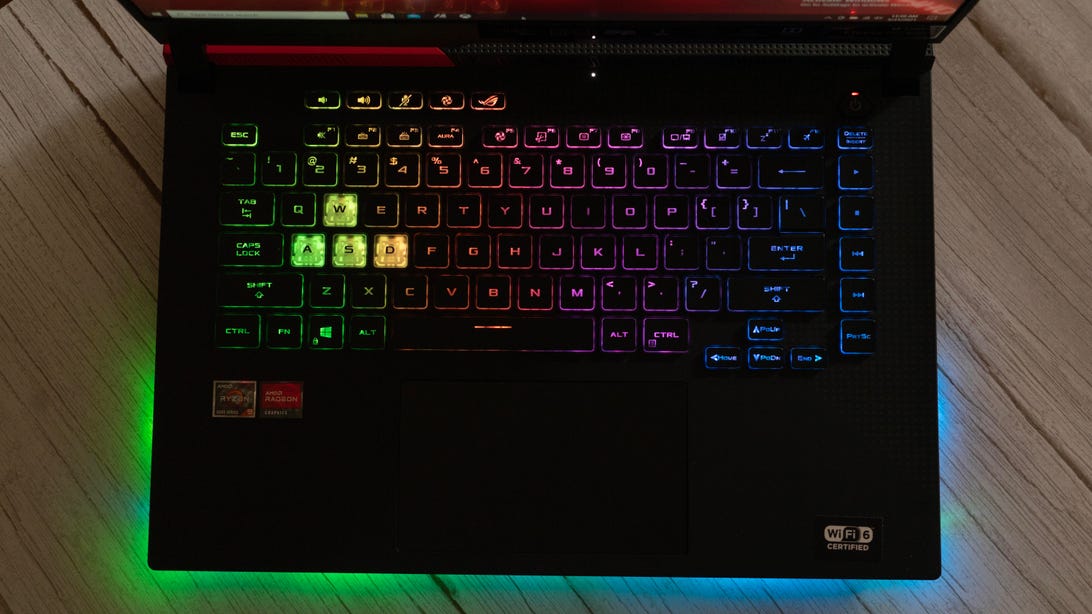
 health
health 
The “Advantage” in this special model of the Asus ROG Strix G15 refers to AMD’s Advantage Design Framework, a new initiative in the spirit of Intel Evo and Nvidia Studio; in AMD’s words, “the result of a multiyear collaboration between AMD and its global PC partners to deliver the next generation of premium, high-performance gaming laptops.” The ROG Strix Advantage Edition is one of the inaugural systems in the program — the only one thus far to include the new Radeon RX 6800M GPU — and while it’s a great gaming laptop and succeeds at hitting “high performance,” it feels a little less premium than competitors and even its own sibling, the ROG Strix Scar 15.
The G15 AE is shipping this month, but Asus hasn’t yet settled on a price; it will fall somewhere in the $1,650-$1,700 range. Even at the high end of that range, though, the G15’s worth it — it delivers excellent performance and features for the money.
The Advantage Design Framework’s requirements include an AMD Ryzen 5000 series CPU (Ryzen 9 5900HX, check), Radeon RX 6000M series GPU (6800M, check), battery life greater than 10 hours (10.5 hours, check), over 100 frames per second in “today’s most visually demanding titles” (check-ish), a display with at least 300 nits brightness and refresh rate of at least 144Hz (bright screen with a 300Hz refresh rate, check) and cool operation under heavy loads (check), “all packed into sleek laptop designs.” Um, I think “sleek” here must be in the eye of the beholder.
There only seems to be a single configuration of the G15, at least for the moment, which means you can’t get the slicker 165Hz 1440p display or optomechanical keyboard used by its sibling system, the Strix Scar 15. Nor can you get it with 32GB RAM. Then again, that Scar configuration costs about twice as much.
| Price as reviewed | TBD, around $1,700 |
|---|---|
| Display | 15-inch 1,920×1,080 300Hz IPS |
| PC CPU | 3.3GHz AMD Ryzen 9 5900HX |
| PC memory | 16GB DDR4 3,200MHz |
| Graphics | 12GB AMD Radeon RX 6800M |
| Storage | 512GB SSD |
| Ports | 1 x USB-C (PD and DP), 3 x USB-A, 1 x HDMI 2.0b, 1 x audio out |
| Networking | MediaTek Wi-Fi 6 MT7921, Bluetooth 5.1, Gigabit Ethernet |
| Operating system | Microsoft Windows 10 Home (20H2) |
| Weight | 5.5 lbs/2.5 kg |
That price difference could be why the Strix G15 feels so much less premium than the similar Scar. This partly defeats the Advantage Design Framework’s implicit intent to change the perception of AMD from being the choice for budget laptops to being the power behind AAA gaming laptops.
It’s not the fastest in its class, but the 6800M punches above its weight, generally falling somewhere between Nvidia’s RTX 3070 and 3080 for gaming and outpacing the RTX 3080 for many creative applications, similarly to what we’ve seen with the desktop GPU equivalents. AMD attributes its performance to a combination of optimized cooling, liquid-metal thermal paste on both the CPU and the GPU and its SmartShift technology, which diverts power to the GPU for a boost when the CPU isn’t very active.
Those are in addition to the general enhancements of the company’s Zen 3 and RDNA 2 architectures, including its Infinity Cache on the GPU die and Smart Access Memory, which allows the CPU to directly access the GPU memory; both improve latency.
It doesn’t get too loud, either. Rather than the whine of a jet engine, in its fastest Turbo mode it sounds more like water boiling. Odd, but kind of soothing.

One big annoyance is that the Radeon RX 6800M lacks an Nvidia Advanced Optimus-like capability to force the system to use the discrete GPU. The only way you can do it is by attaching an external display via USB-C, which isn’t a practical solution for many people. Even the HDMI connection isn’t on the GPU bus.
Yes, AMD’s automation probably delivers optimal results 99% of the time, but for the 1% when, say, you can’t figure out why Photoshop doesn’t see the GPU or you encounter other problems that need troubleshooting, the option is essential. Like when Far Cry 5 delivered repeated runs at about 19fps for me because it insisted on using the integrated GPU; attaching an external display “snapped” it to the discrete GPU, which then stuck. Frame rates generally improved when I used an external display as well, which makes sense, since it’s on the faster bus.
AMD targets the 6800M at 1440p/120fps gaming, so it’s odd that the Strix G15 pairs it with a 1080p display. Attached to an external display and running in Turbo mode, you’ll probably get those frame rates in many games. (We test using the laptop display and the numbers we report are for the default, middle-of-the-road Performance mode.)
The Strix models are generally somewhat heavy and bulky, but the G15 Advantage goes the extra mile with an even larger power adapter: The AMD CPU/GPU combination requires a 280-watt supply compared with, say, the 240 watts needed by the AMD CPU/Nvidia GPU combo in the Scar.
I wish there were at least one more USB-C connector. The 512GB solid-state drive is on the small side and I would have liked to connect both a portable USB-C drive and a USB-C monitor simultaneously. Thunderbolt would have been even nicer, but this is AMD.

In most other respects, the G15 seems well designed. The keyboard may not be as slick as the Scar’s optomechanical version, but in many ways I like it better. It doesn’t have the mechanical clickiness I like, but it has good travel that can take a pounding. The matte, grippy, slightly curved keycaps feel more precise and less slippery. On the other hand, the keycaps seem potentially flimsy and prone to collecting crumbs.
The backlight is only four zones, not per-key RGB, and it doesn’t shine quite brightly enough through small characters like quotation marks, the apostrophe and the period. But I’m a big fan of the lighting strip around the base, and the translucent WASD keys are a nice touch as well.
It also has a big touchpad, and while the keyboard lacks an embedded number pad, I still like it better than the virtual number pad on the Scar, which pops into service too easily.
But how someone can ship a laptop in 2021 without a webcam boggles the mind. To take part in Zoom chats and the like, you’ll need to hook up an external cam.
The Asus ROG Strix G15 Advantage Edition isn’t a perfect gaming laptop, and it probably won’t be the fastest one we see this year, but it’s damn good and damn fast, especially for the money.
Razer Blade 15 Advanced (early 2021)
Asus ROG Strix G15 Advantage Edition (G513QY)
Asus ROG Strix Scar 15 (G533QS)
Longer bars indicate better performance
Razer Blade 15 Advanced (early 2021)
Asus ROG Strix Scar 15 (G533QS)
Asus ROG Strix G15 Advantage Edition (G513QY)
Longer bars indicate better performance
Razer Blade 15 Advanced (early 2021)
Asus ROG Strix Scar 15 (G533QS)
Asus ROG Strix G15 Advantage Edition (G513QY)
Longer bars indicate better performance
Razer Blade 15 Advanced (early 2021)
Asus ROG Strix Scar 15 (G533QS)
Asus ROG Strix G15 Advantage Edition (G513QY)
Longer bars indicate better performance
Asus ROG Strix G15 Advantage Edition (G513QY)
Asus ROG Strix Scar 15 (G533QS)
Razer Blade 15 Advanced (early 2021)
NOTE: Longer bars indicate better performance (FPS)
Asus ROG Strix Scar 15 (G533QS)
Asus ROG Strix G15 Advantage Edition (G513QY)
Razer Blade 15 Advanced (early 2021)
Longer bars indicate better performance (FPS)
Razer Blade 15 Advanced (early 2021)
Asus ROG Strix Scar 15 (G533QS)
Asus ROG Strix G15 Advantage Edition (G513QY)
NOTE: Longer bars indicate better performance
Razer Blade 15 Advanced (early 2021)
Asus ROG Strix G15 Advantage Edition (G513QY)
Asus ROG Strix Scar 15 (G533QS)
Longer bars indicate better performance
Asus ROG Strix Scar 15 (G533QS)
Asus ROG Strix G15 Advantage Edition (G513QY)
Razer Blade 15 Advanced (early 2021)
Longer bars indicate better performance (FPS)
| Asus ROG Flow X13 | Microsoft Windows 10 Home (2004); 3.3GHz AMD Ryzen 9 5900HS; 16GB DDR4 SDRAM 4,266MHz; 4GB Nvidia GeForce GTX 1650; 1TB SSD |
|---|---|
| Asus ROG Strix G15 AMD Advantage Edition | Microsoft Windows 10 Home (21H1); 3.3GHz AMD Ryzen 9 5900HX; 16GB DDR4 SDRAM 3,200MHz; 12GB AMD Radeon RX 6800M; 512TB SSD |
| Asus ROG Strix Scar 15 | Microsoft Windows 10 Pro; 3.3GHz AMD Ryzen 9 5900HX; 32GB DDR4 SDRAM 3,200MHz; 10GB Nvidia GeForce RTX 3080; 1TB SSD |
| Razer Blade 15 Advanced (early 2021) | Microsoft Windows 10 Home (2009); 2.3GHz Intel Core i7-10875H; 16GB DDR4 SDRAM 3,200MHz; 8GB Nvidia GeForce RTX 3070 Max-Q; 1TB SSD |
24World Media does not take any responsibility of the information you see on this page. The content this page contains is from independent third-party content provider. If you have any concerns regarding the content, please free to write us here: contact@24worldmedia.com